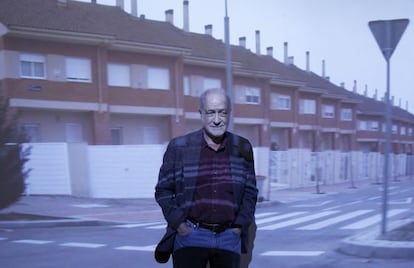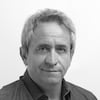Bursting the property bubble in the gallery
Hans Haacke brings his vision of a failed Madrid housing project to the Reina Sofía

Behind the work of art is the artist. And the gallery owner. And the museum director. And the curator. And the museum trustees. And the gallery shareholders. And the intermediaries. And the director of a contemporary art fair. And the mayor who inaugurates the artist's exhibition. And the mayor's friends. And the CEO of the company that is sponsoring the show.
This is the kind of network that the public rarely ever knows about, nor should they, if all they want to get out of art is pleasure. But some people believe that art, besides pleasure, can also trigger reflection and even indignation. These inquisitive individuals want to know everything: the how, the when, the where, the why and the thanks to whom things happen in the art world. They want to know about the relationship between art and power. And for these information-hungry people, Hans Haacke is their man.
A furious cross between an artist and an investigative reporter, this native of Cologne has spent around half a century raising the hackles of important people, with the foreseeable results. A walking, talking paradox in the art market, he has left a trail that lies at the epicenter of a contradiction: he is a creator who seeks to erode and undermine the pillars of the system and its owners, yet at the same time he is a highly prized creator within the system itself.
Only a few days ago, shortly after the opening of Arco, Spain's leading contemporary art fair, Haacke could be overheard saying: "Works of mine at Arco? I've told my gallery representative a million times I don't want any of my work at art fairs!"
Because his inner drive to unearth foul-smelling deals is visceral and non-negotiable, this free electron who hovers somewhere between art, anthropology, sociology, economics and real estate zoning has had his share of fallouts with museum chiefs throughout his career. And yet they keep inviting him, aware they are inviting the devil.
Just ask the former director of the Guggenheim in New York, Thomas Messer, who in 1971 censored and canceled Haacke's show revolving around the properties owned by two Manhattan multimillionaires, Sol Goldman and Alex DiLorenzo. Haacke had made a count of all the buildings both men owned on the island. Messer alleged that this was not art. Around 100 artists protested and announced they would never show their work at the Guggenheim again. The New York Police Department did show an interest in the issue, however, and investigated Goldman and DiLorenzo over possible dealings with Manhattan's underworld.
Or ask the heads of MoMA: they never accepted the fierce clauses that Haacke includes in his contracts with clients, including the right to control the way and the place where his work is displayed, and in the case of gallery owners, the right to a share of the benefits, no matter when a sale is made. Or the heads of the Philip Morris tobacco empire, whom he took to pieces in his 1990 piece Cowboy with Cigarette, a furious reaction against the company's sponsorship of a Picasso and Braque exhibition at MoMA. He even irked the execs at Barcelona's Miró Foundation, who in 1991 rejected an exhibition called Obra social that eventually ended up at the city's Tàpies Foundation instead.
Right now, the devil has taken up residence at Madrid's Reina Sofía museum, where director Manuel Borja-Villel curates a show called Castillos en el aire (Castles in the air), a tribute to an artist who, as Borja-Villel notes, "neither criticizes nor denounces, but simply states."
After taking a look at what's inside the rooms of the Reina Sofía, however, it is obvious that in some cases at least, stating is tantamount to denouncing. Haacke does it with relish and with infinite sarcasm, although everything is presented with great elegance.
On one of his visits to Madrid two years ago, Hans Haacke - who was searching for a topic for his Reina Sofía show - discovered the surreal world of Ensanche de Vallecas, south of the city center. It was there that, mouth agape, he found an enormous residential area full of apartment blocks sitting empty or half-finished, "an absolutely deserted neighborhood where you never saw a soul, although everything was full of signs and children's playgrounds," he recalls. To top it all off, the streets had names like Conceptual Art St., Expressionist Art St., Minimalist Art St., Pop Art St. and so on.
"That vision was the spark of this exhibition: the direct relationship between ruin and the world of art," explains Haacke, who asked to be taken on a van tour of the area in order to tape a video that is now being screened on a giant wall at the Reina Sofía.
But the real castle in the air is in the next room: hundreds of property records of all these housing units that were stillborn - the offspring of bankrupt developers now immortalized by the artist in over 2,000 photographs and images, aided by Silvia Herrero, a professor of zoning laws, and Ana Méndez, a landscape architect. The images show the scrub growing through the chipped floors and the rusty structures of what should have been enormous buildings, which look like so many terrifying sirens trapped in a universe of absurdity and speculation.
Tu suscripción se está usando en otro dispositivo
¿Quieres añadir otro usuario a tu suscripción?
Si continúas leyendo en este dispositivo, no se podrá leer en el otro.
FlechaTu suscripción se está usando en otro dispositivo y solo puedes acceder a EL PAÍS desde un dispositivo a la vez.
Si quieres compartir tu cuenta, cambia tu suscripción a la modalidad Premium, así podrás añadir otro usuario. Cada uno accederá con su propia cuenta de email, lo que os permitirá personalizar vuestra experiencia en EL PAÍS.
¿Tienes una suscripción de empresa? Accede aquí para contratar más cuentas.
En el caso de no saber quién está usando tu cuenta, te recomendamos cambiar tu contraseña aquí.
Si decides continuar compartiendo tu cuenta, este mensaje se mostrará en tu dispositivo y en el de la otra persona que está usando tu cuenta de forma indefinida, afectando a tu experiencia de lectura. Puedes consultar aquí los términos y condiciones de la suscripción digital.
Últimas noticias
Maduro pleads not guilty before the federal court in New York: ‘I am still the president of Venezuela’
A new test can detect Alzheimer’s from a finger prick
UN team enters Sudanese city of El Fasher after paramilitary massacre: ‘It’s like a ghost town’
A recipe for resistance: Indigenous peoples politicize their struggles from the kitchen
Most viewed
- Gilles Lipovetsky: ‘If you want to live better and fall in love, take Prozac, don’t look to philosophy’
- Alain Aspect, Nobel laureate in physics: ‘Einstein was so smart that he would have had to recognize quantum entanglement’
- Alvin Hellerstein, a 92-year-old judge appointed by Bill Clinton, to preside over Maduro’s trial in New York
- Why oil has been at the center of Venezuela-US conflicts for decades
- Maduro’s downfall puts China’s relationship with Venezuela to the test









































